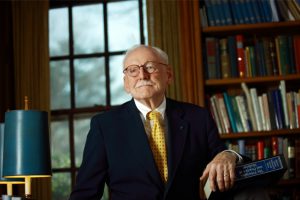
The following was originally published in Johns Hopkins Medicine’s Newsroom.
Richard J. Johns, a medical visionary who was the founding director of Johns Hopkins’ Department of Biomedical Engineering and oversaw its development into an internationally recognized program with a record of impact across many disciplines, died Nov. 29 of complications of dementia. He was 95.
Johns was a 1948 graduate of the Johns Hopkins University School of Medicine. He directed biomedical engineering from its founding as a department of the school of medicine in 1970 until 1991. It has since become a department jointly operated by the schools of engineering and medicine.
Johns fostered research in hearing, speech, cardiovascular control and myocardial mechanics, as well as development of better instruments and tools for treating a wide variety of medical conditions. He also established close research collaborations with the Johns Hopkins University Applied Physics Laboratory, including development of the use of the argon laser for retinal surgery.
“Richard Johns, together with his wife Carol Johns, represented much of what is so special about Johns Hopkins. They were brilliant, collaborative, generous, visionary and relentlessly productive,” says Mark Anderson, M.D., Ph.D., the William Osler Professor of Medicine, director of the Department of Medicine at the Johns Hopkins University School of Medicine and physician-in-chief at The Johns Hopkins Hospital.
Johns received his bachelor’s degree from the University of Oregon and focused on physics rather than engineering or biology, despite his continuing interest in mechanics and medicine.
While he was a medical student at Johns Hopkins, Johns became a laboratory technician for Samuel Talbot, one of the founders of the biomedical engineering field as the then head of a biophysical division in the Department of Medicine. Johns quickly became proficient in building oscilloscopes, used to measure the heartbeats and brain waves of patients, and other devices for making physiological measurements.
“The university’s leadership in biomedical engineering, the vast innovations and advances made by our faculty, students and alumni that have improved the lives of so many, are a direct result of Dick Johns’ vision and his understanding of what is possible when you bring engineering and medicine together as an integrated collaborative effort,” says Ed Schlesinger, Ph.D., the Benjamin T. Rome Dean of the Whiting School of Engineering at The Johns Hopkins University.
After a year as a Johns Hopkins intern, Johns spent two years of required Army service studying the effects of nerve gas on the central nervous system of animals. He returned to Johns Hopkins as a resident and then a postdoctoral fellow before being appointed to the faculty of the Department of Medicine.
Although he maintained a clinical practice and taught medical students, Johns also pursued biomedical research. His work determined the biological origins of myasthenia gravis, a chronic neuromuscular disorder, and he was instrumental in developing a revolutionary, 3D radiography system, among other breakthroughs.
Johns was named the first professor of biomedical engineering in 1966, and appointed head of a new Division of Biomedical Engineering in the Department of Medicine. It became a full department of the school of medicine in 1970, with Johns as its first director, and later changed structure to be jointly operated by the schools of medicine and engineering. The department consistently ranks as the #1 biomedical engineering program in U.S. News & World Report.
Johns received numerous honors, including election to the Institute of Medicine (now the National Academy of Medicine) in 1986, and an honorary doctor of humane letters degree from Johns Hopkins in 2009. He was also named university distinguished service professor at Johns Hopkins.
A deep commitment to Johns Hopkins Medicine was central to Johns’ private life as well as his professional one. His wife, the late Carol Johnson Johns, M.D., whom he met when they both were medical residents, was a renowned expert in lung diseases, served as an assistant dean of the medical school and was a founder of the school’s Task Force on Women’s Academic Careers in Medicine. They spent a combined 130 years at Johns Hopkins.
Johns was born in Pendleton, Oregon, in 1925 to James Shanard Johns and Mary Pearl McKenna Johns. He is survived by three sons, James Johns, M.D., Richard Johns and Robert Johns, seven grandchildren, one great-granddaughter and other extended family members. A memorial service will be planned at a later time.